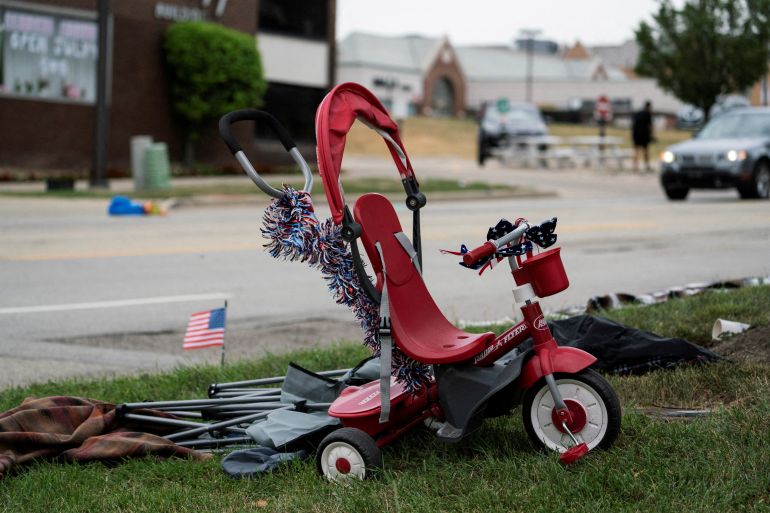The ‘terror’ in Highland Park: The US is exceptional, indeed
But why is it that American ‘exceptionalism’ is now manifested in such uniquely unhinged episodes of mass murder?

On the morning of Monday, July 4, as the United States was gearing up for its 246th annual celebration of independence from Britain, the National Rifle Association (NRA) – America’s ultra-powerful gun rights organisation – offered the following inspirational reminder on Twitter: “The only reason you’re celebrating Independence Day is because citizens were armed”. The tweet ended with the hashtag “#FourthofJuly”.
This was before Monday’s mass shooting in the affluent Chicago, Illinois suburb of Highland Park killed seven people and wounded dozens of others at July 4 festivities in what Highland Park Mayor Nancy Rotering described as an act of “terror that was brought upon us”. Parents with strollers and children on tricycles fled for their lives. And yet the horrific casualty toll was not even the tip of the iceberg in terms of things that can happen “because citizens were armed”.
As NBC Chicago reported before the clock had even struck 9am on Monday, at least 57 people had already been shot in the city of Chicago alone over the Fourth of July weekend – nine of them fatally. Nationwide as of July 4, the US had registered no fewer than 309 mass shootings in 2022, according to the Washington, DC-based Gun Violence Archive, which defines a mass shooting as one with “a minimum of four victims shot, either injured or killed, not including any shooter”.
There are more guns than people in the US, and this is certainly a large part of the problem – particularly as states like Texas, which recently hosted the Uvalde massacre of 19 elementary school students and two teachers, ensure that it is essentially as easy to acquire a firearm as it is to acquire laundry detergent.
But why is it that American “exceptionalism” – which we have been hearing about since the 1830s or so – is now manifested in such uniquely unhinged episodes of mass murder?
I am not saying, obviously, that humans do not kill each other in other countries. They do, and, as luck has had it, the US itself has often been complicit in that killing – from the traditional right-wing slaughter of peasants in Latin America to the systematic terrorisation of Palestinians that Israel undertakes under the guise of fighting terror.
Then there is the more hands-on “global war on terror” and other initiatives directly perpetrated by the US military – which, one could argue, have only helped instil in Americans the notion that life is a video game and that it is absolutely fine to go around slaying people.
And while the majority of annual gun-related deaths in the US take the form of run-of-the-mill suicides and homicides rather than Highland Park-type spectacles, mass shootings naturally have a more terrorising effect on public consciousness.
In the latter category of event, as it turns out, there is also a frequent common denominator. In June, the Washington Post reported that, as per the paper’s own analysis of 196 mass public shootings since 1966, “nearly 98 percent” of the perpetrators were found to be men, with 40 percent of them between the ages of 18 and 29.
The Post went on to quote an observation by psychologist Peter Langman, an expert on school shootings, in The Journal of Campus Behavioural Intervention: “The sense of damaged masculinity is common to many shooters and often involves failures and inadequacies.”
To be sure, in a society predicated on violently patriarchal capitalism and mass alienation – in which collective, collaborative existence is abandoned in favour of a focus on dog-eat-dog individual triumph – it is perhaps less than shocking that perceived “failures and inadequacies” might sometimes produce violent, overly masculine responses.
This is no doubt especially the case with disillusioned young white men, who according to the American script are the ones supposed to be doing most of the triumphing. Indeed, in 2021, NPR cited statistics from the nonpartisan research group The Violence Project indicating that “white men are disproportionately responsible for mass shootings more than any other group”.
In the end, it seems that when young men are sufficiently alienated and isolated by a society whose expectations they have failed to fulfil – and vice versa – some opt to just shoot it all up.
The 18-year-old Uvalde shooter was bullied extensively during his youth; ditto for other killers whose visions of revenge against society have been greatly facilitated by easy access to weaponry.
For his part, the 21-year-old suspect in the July 4 Illinois massacre is described by the Daily Beast as a “wannabe rapper” and apparent “video-game enthusiast”, whose social media operations suggested a predilection for “violent imagery and mass-shooting fantasy”.
In her remarks following the shooting, Mayor Rotering lamented: “On a day that we came together to celebrate community and freedom, we are instead mourning the tragic loss of life.” But while the tragedy and terror are very real, it bears remembering that July 4 itself commemorates the “freedom” of a nation founded on genocide and slavery – another contributing factor, you might say, to America’s high degree of “exceptionalism”.
And as American violence proceeds unhinged, the truth of the matter is that it has all become tragically unexceptional.
The views expressed in this article are the author’s own and do not necessarily reflect Al Jazeera’s editorial stance.
